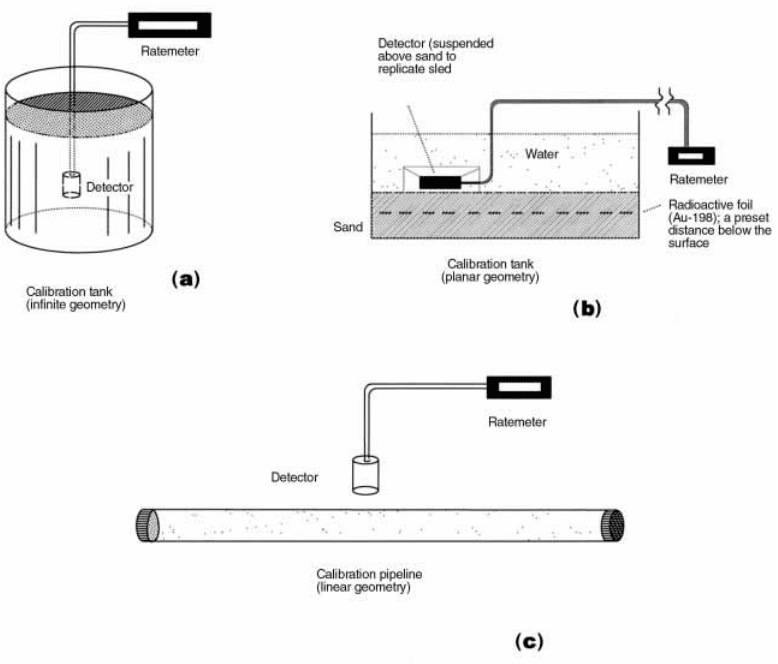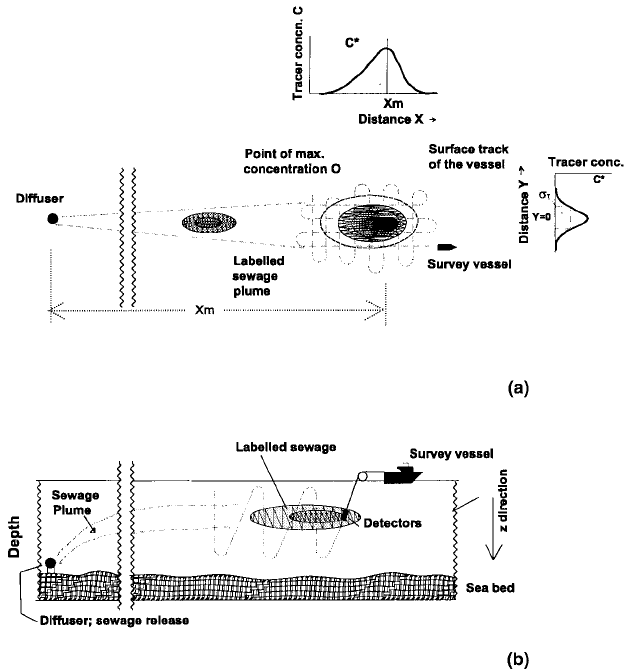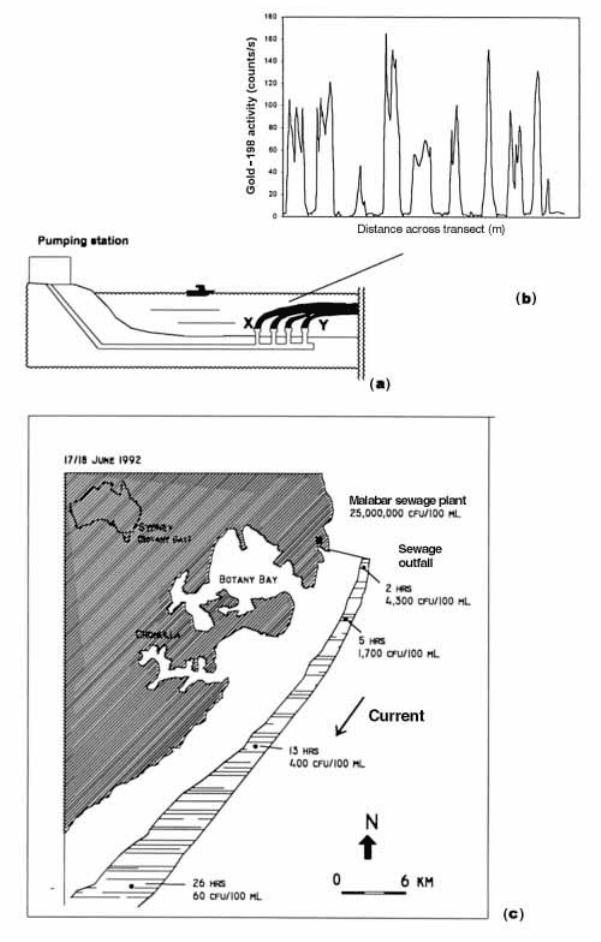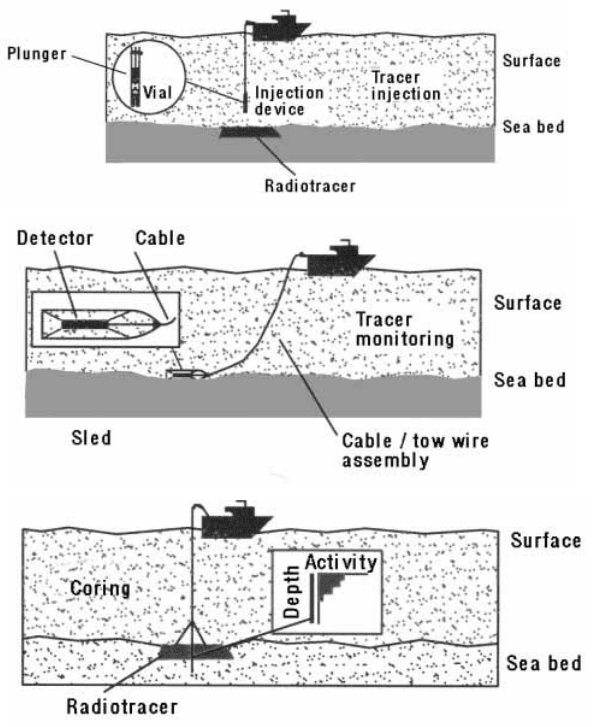Lowenthal G., Airey P. Practical Applications of Radioactivity and Nuclear Radiations
Подождите немного. Документ загружается.

simple as possible. For instance, injection may be effected by transferring the
vial to a bottle-breaking device using remote handling equipment, immersing
the device in the middle of the river below the surface and breaking the vial
by releasing a heavy weight.
The river is sampled downstream at a constant rate q (l/s) (Figure 9.1(a)).
Sampling is commenced before the arrival of the radioactive pulse and
completed only after the pulse has passed. Assuming complete mixing has
been achieved between injection and sampling, the total activity collected
during sampling a (Bq) will be independent of the speci®c location of the
sampling point. If the activity of the injected tritium is A (Bq), then the ¯ow
rate of the river Q (l/s) is given by Eq. (8.4), namely
Q = qA/a (9.1)
The total count method
The principal disadvantage of the tritium method is that the diluted samples
must be returned to the laboratory for activity measurements. A gamma
emitting radiotracer is therefore often preferred and the total count method
applied. The isotopes
82
Br or
99m
Tc, eluted from a molybdenum/technetium
generator, are often used. Here, the data are collected in real time using ®eld
NaI(Tl) gamma detectors (Figure 9.1(b)) immersed in the stream. If N is the
total number of counts accumulated by the counter during the passage of the
complete pulse (corrected for background and decay), the ¯ow rate Q (l/s) is
given by Eq. (8.8), namely
Q = AF/N (9.2)
where A (Bq) is the activity of the injected radiotracer and F (cps per Bq/l) is
the calibration factor for the detector.
The accuracy of river ¯ow measurements depends on the accuracy of the
calibration of the detection equipment, a point referred to in Section 8.2.4
when reference was made to the problem of reproducing in the laboratory the
counting geometry found in the ®eld. In most estuarine and offshore studies,
the detector probes are completely immersed in the water, a geometry which
has been described as quasi-in®nite. These conditions are replicated in the
laboratory by positioning the detector in the centre of a large cylindrical tank
and recording the countrate following additions of known activities of the
isotope of interest. The tank must be large enough to avoid wall effects. The
dimensions depend on the penetrating power of the g rays. A cylindrical tank
of 1 m radius and 2 m height is normally adequate to approximate in®nite
geometry since the half thickness in water of a 1 MeV g ray is only about
10 cm (Figure 9.2(a)).
9.3 Environmental applications of radioisotopes 281

As with the total sample method, it is assumed that the conditions for
complete mixing have been met (Section 8.3.1). Complete mixing is achieved
when the total count during the passage of the radioactive plume is
independent of the location of the detector in the river. Clearly, it is seldom
possible to con®rm this experimentally in a ®eld investigation. The concept of
the mixing length has therefore been introduced. If the distance from the
point of injection to the point of measurement exceeds this value, complete
Radionuclides to protect the environment282
Figure 9.2. Field calibration geometries. Three limiting cases. (a) Quasi-in®nite
geometry. The isotope of known speci®c activity is dispersed in a tank large enough
to avoid wall effects. The ®eld detector is positioned in the centre. Multiple readings
are made and the calibration factor F reported as (cps per Bq/l). (b) Quasi-planar
geometry. Small calibrated sources (e.g.
198
Au foils) are set in a uniform pattern, a
®xed distan ce below the surface of the sand. The detector is set in place and the
countrate noted. The calibration factor F (cps per Bq/m
2
) is measured at a number of
different depths. (c) Quasi-linear geometry. A calibration pipeline, as similar as
possible to the test line, is ®lled with a solution of known speci®c activity. The
detector is located as in the test and the calibration factor F measured in cps per Bq/l.

Table 9.3.
The mixing lengths in rivers.
a
Injection point Formula
Legend
Comments
Centre
L
=50Q
1/3
L the mixing length;
Q the volume ¯ow
Hull formulae, reported by J. Guizerix and
T. Florkowski in IAEA (1983, Ch. 5)
Bank
Centre
Bank
L = 200 Q
1/3
L
b
= 0.1 u
x
w/D
T
L
b
= 0.4 u
x
w/D
T
L the mixing length;
u
x
the mean velocity at
measurement cross-section
w the width of the river;
D
T
the transverse disposition
coef®cient
After Fisher
et al. (1979)
c
Notes:
a
Any formula can only provide an estimate of the distance required for
mixing. In situ tests are required for a ®rm determination
of
L.
b
A degree of mixing of 95% is assumed. The degree of mixing is the
extent to which mixing has been achieved in a cross section
downstream from the injection of the tracer.
c
Please also note the Draft Internati onal Standard: ISO/DIS 555-3
Liquid Flow Methods in Open Channel ± Dilution Methods for the
Measurement of Steady Flow
Part 3:
Radioactive Tracers
(Published/Created: Geneva: ISO, 1991)
mixing may be assumed. A number of empirical expressions for the mixing
length have been developed, some of which are listed in Table 9.3.
For further information on the gauging of rivers, readers are referred to
IAEA (1983).
9.3.3 Studies of the dispersion of contaminants
Competition for environmental resources
The pollution of river systems and the coastal zone by industrial ef¯uents and
sewage is of major concern. The needs of city populations and industries to
dispose of ef¯uents must be balanced against public health issues as well as
the desires of recreational users and the tourist industry for pollution-free
environments. Management of these competing demands requires a robust
method for predicting the impact of contaminant releases on the local
ecosystems. The purpose of this section is to demonstrate that radiotracer
techniques can offer powerful tools for validating predictive mathematical
models, so greatly increasing the con®dence with which these models can be
used. Readers are referred to Lewis (1997) for further information on
dispersion in estuarine and coastal waters.
Dispersion of contaminants
The transport of contaminants in rivers and other receiving waters may be
studied by injecting a pulse of a radiotracer mimicking the pollutant and
observing its subsequent behaviour. Close to the point of injection, the
radioactive plume is carried by advective ¯ow and it also disperses in three
dimensions. The dispersion of solute (or tracer) is caused by the turbulent
structure of the ¯uid.
Neglecting the effects of boundaries, the concentration pro®le of a tracer
following a pulse injection resembles a Gaussian distribution (Figure 9.3(a)) ±
a useful fact since these distributions are well known from numerous
applications.
The ®gure shows that there are two components to the transport of the
tracer, namely advective transport and dispersion. Advective transport of a
contaminant is that due to the bulk movement of the water. In this discussion,
the bulk ¯ow is in the longitudinal L (or x) direction. The advective ¯ux f
adv,
u
x
is the product of the average ¯ow rate of the water, u
x
(l/s) through a cross
section, and the average concentration of the contaminant C, i.e.
f
adv,L
= u
x
C. (9.3)
Radionuclides to protect the environment284

In addition, contaminants are dispersed and diluted within the receiving
waters, principally as a consequence of the turbulent structure of the water.
These processes are important in determining the fate and behaviour of the
contaminants. The ef®ciency of dispersion is often quanti®ed in terms of
dispersion coef®cients which are de®ned in terms of Eq. (9.4). Some of the
basic theory is introduced in Appendix 5. It suf®ces to say that tracer
techniques offer the most direct method of estimating dispersion coef®cients
in the ®eld.
9.3 Environmental applications of radioisotopes 285
Figure 9.3. The dispersion of tracer injected as a pulse. (a) The longitudinal (x) and
transverse (y) dispersion of the pulse. The concentration pro®le in the transverse
direction approaches a Gaussian distribution in the far ®eld. (b) The dispersion of
the plume in the vertical (z) direction. The scheme for tracking the plume in the three
dimensions is shown.
An analytical treatment of dispersion
Following the instantaneous injection of a tracer of activity A
o
, concentration
pro®les may be monitored in three dimensions. Taking as a reference point,
the maximum tracer concentration (O, Figure 9.3(a)), the pro®le in the
transverse (or y) direction may be expressed in the form (Eq. (A5.12))
C(y,t)=C
y
* exp[7(y7y
m
)
2
/4D
T
t] (9.4)
where y is the location on the transverse axis from the point of maximum
concentration y
m
; C(y,t) is the concentration of the tracer at the location y
and time t; D
T
is the transverse dispersion coef®cient; and C
y
* is the tracer
activity at the maximum concentration (O) on the transverse (y) axis.
Comparing Eq. (9.4) with the expression for the Gaussian distribution (Eq.
(6.10)) it is seen that the variance (s
2
) is given by
s
2
=2D
T
t. (9.5)
The expression corresponding to Eq. (9.4) for dispersion in the longitudinal
or x direction is
C(x,t)=C
x
* exp [7(x7x
m
)
2
/4D
L
t]. (9.6)
The maximum value of the tracer concentration occurs at O or x
m
(where
x
m
= u
L
t). Equation (9.6) is only an approximation, as, in practice, the tracer
plumes normally exhibit a substantial `tail' as shown in Figure 9.3(a). When
the advective velocity u
L
is constant, the longitudinal dispersion coef®cient
D
L
may be replaced by the dispersivity a
L
where
a
L=
D
L
/u
L
. (9.7)
The Gaussian approximation is widely used in studies of the dispersion of
contaminants in waterways. Following the release of the tracer, the radio-
activity levels are tracked in a systematic way and the shape of the dispersed
plume is reconstructed. The dispersion coef®cients or mixing functions are
calculated from Eqs. (9.4) and (9.6). Details of the calculations are presented
in Appendix 5. A case study on sewage dispersion follows in Section 9.3.4.
Elaborate ¯uid dynamic codes have been developed to describe transport
processes in rivers, estuaries and the coastal zone. However, details are
beyond the scope of this text.
9.3.4 A case study: sewage dispersion
The monitoring of the dispersion of sewage and other contaminants into
waterways is an application of radiotracers of demonstrated usefulness and
Radionuclides to protect the environment286
will here serve as a case study. Many major cities around the world are
located on the coastal zone, and their sewage is frequently disposed of
through deep ocean outfalls following pre-treatment. The ef¯uent is pumped
a substantial distance offshore and released at intervals through a series of
diffuser heads (Figure 9.4(a)). The aim of the engineering works is to
minimise any impact of the sewage release on sensitive regions such as
bathing beaches or the spawning grounds of ®shes because of the potential
impact on public health.
The evaluation of the performance of such outfalls involves the modelling
of sewage ef¯uent from close to the point of release to far into the deep ocean.
Model validation is commonly effected by injecting radioactive tracers into
the sewage ef¯uent, and monitoring the dispersion of the radioactive plume
for many kilometres from the underwater release point. The radiotracers are
commonly gold-198 and tritiated water HTO. The period of injection usually
varies from one to 12 hours.
The activity of the g ray emitting gold-198 (Table 8.1) is measured with
submerged detectors. The data are combined with those from depth meters
and positioning equipment to allow the development of a three dimensional
visualisation of the dispersed sewage. The tritium levels serve for an accurate
measurement of the dilution factors. Water samples are taken and returned
to the laboratory for measurement, together with records of the position,
depth and gold-198 countrates.
The radiotracers permit detailed studies of the behaviour of the contami-
nants. Close to the outfall, the performance of individual diffusers can be
readily distinguished (Figure 9.4(b)). The dilution factors may be measured
and compared directly with speci®cations. Occasionally, partial or complete
blockages of the diffusers are observed. The dispersion of the plume may be
traced systematically into the so-called far ®eld.
An example is presented (Figure 9.4(c)) of a study of the dispersion of
sewage from the Malabar outfall, which serves part of Sydney and discharges
into the ocean at 80 m depth some 4 km offshore. Plumes have been tracked
in the ocean for distances up to 35 km from the point of release.
Treated sewage is a complex mixture of dissolved aqueous contaminants,
suspended particulates and dispersed greases. Using radionuclides, these
different components of the sewage plume can be tagged independently and
studied separately. For example, the aqueous components of the sewage are
labelled with tritiated water; the ®ne particulates with gold-198 and the
organic grease component of the sewage with tritiated organic compounds.
In more elaborate investigations, the levels of bacteria introduced into the
water with the sewage are measured and the results corrected for dilution in
9.3 Environmental applications of radioisotopes 287

Radionuclides to protect the environment288
Figure 9.4. (a) Sketch of an outfall with labelled sewage dispersing from multiple
diffusers. The merging of the plume is shown. (b) The response of the radiation
detector tracking close to the diffusers. The technique for tracking the dispersing
plume is shown in Figure 9.3(b). (c) A radioisotope study of the dispersion of sewage
from a deep ocean outfall near Sydney, Australia. Observations were made for over
26 hours. The levels of bacteria in the sea water are shown as the empirical measure
colony forming units (CFU).
the ocean using the tritium measurements. It is then possible to determine a
true `die off ' rate for the bacteria under the conditions found in the ocean.
The results of such an investigation are shown in Figure 9.4(c) (Pritchard et
al., 1993).
9.3.5 Applications of tracer techniques to sediment and sand tracing
Measurements of migration rates
The assessment of major proposals for port and harbour development
frequently calls for a sound knowledge of the offshore migration of sand and
sediment. Measurements of migration rates could extend from a few days to
over a year depending on the processes of interest. The radionuclides are
chosen to suit the duration of the investigation. For example,
198
Au
(T
1/2
= 2.7 d) has a useful life of about two weeks,
51
Cr (T
1/2
= 27.7 d) about
four months,
192
Ir (T
1/2
= 73.8 d) about eight months,
46
Sc (T
1/2
= 83.8 d)
about nine months and
110m
Ag (T
1/2
= 250 d) over one year.
To label the sand or sediment, the radiotracer is either adsorbed onto the
surface of the sand, or incorporated into a glass and ground and sieved to
match the particle size distribution of the material of interest. The radio-
labelled material is released using remote handling techniques (Figure 9.5(a))
and is monitored on the sea bed using calibrated detectors attached to a sled
or other device constructed to ensure reproducible source±detector geometry
(Figure 9.5(b)). It is then possible to make quantitative estimates of the rate
of bed load transport of the sediments. The calibration of the detectors is
discussed below.
The current status of the technology is illustrated in a long-term investiga-
tion of the migration of sand at a depth of 68 m (Figure 9.5(d)). The aim of
the study was to examine the effect of storms on the movement of sand at
depth. This was effected by labelling glass beads with the same particle size
distribution as the sand with iridium-192 (half life 74 days). The tracer was
transported to the site in three separate vials and released about 2 m from the
bottom using a detonation technique. With modern position ®xing tech-
niques, changes in the activity pro®le of the labelled sand can be measured
within a few metres. In this particular instance, little movement was observed
over three months, despite some signi®cant storm activity.
Coastal engineering demonstrations
The technique has been widely applied to coastal engineering investigations,
examples include the following.
9.3 Environmental applications of radioisotopes 289

. Shipping channels: bed load transport studies may be used to optimise the
alignment of dredged shipping channels. For instance, tracer studies have been
used to measure the rate of littoral drift whic h will lead to in ®lling of the proposed
channel and the need for ongoing maintenance.
. Location of dredge spoil grounds: optimising the location of dredge spoil grounds
Radionuclides to protect the environment290
(a)
(b)
(c)
Figure 9.5. Application of tracer techniques to sedim ent migration. (a) Injection of
the tracer using a bottle breaker technique. For depths greater than, say, 20 m a
detonator technique for dispersing the tracer has advantages. (b) The tracking of the
labelled sediment for periods ranging from a few days to many months. (c) The depth
distribution of the tracer is best obtained by coring. (d) Case study showing that sand
moves very slowly at a depth of 68 m over a period of over 3 months. (e) Case study
showing that the direction of bed load transport can vary across a channel depending
on the net effect of the current patterns. (f ) Schematic representation of nucleonic
sediment gauges; a transmission gauge (left) and a backscatter gauge (right).
